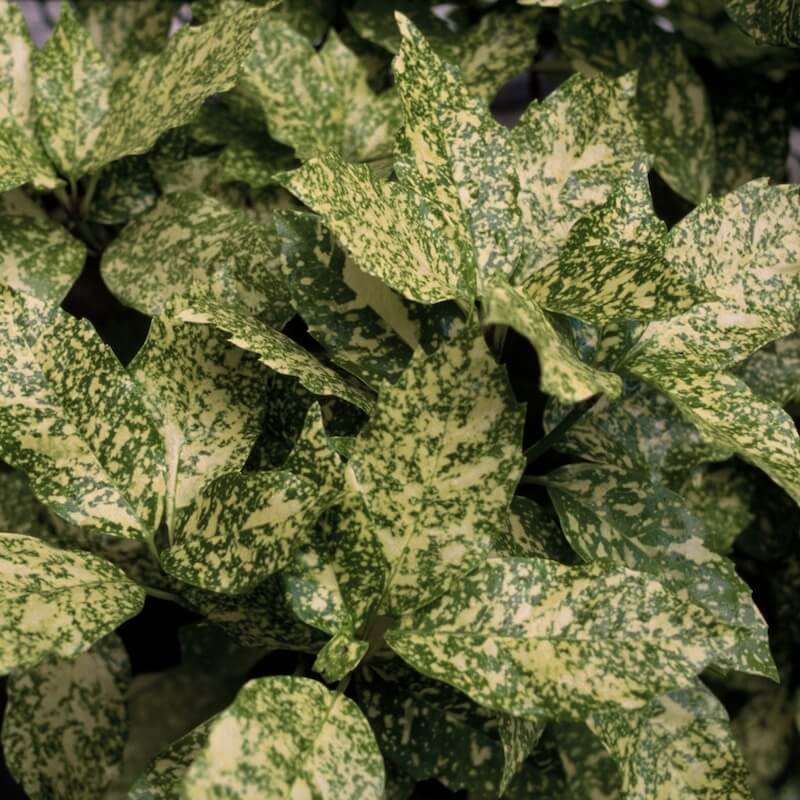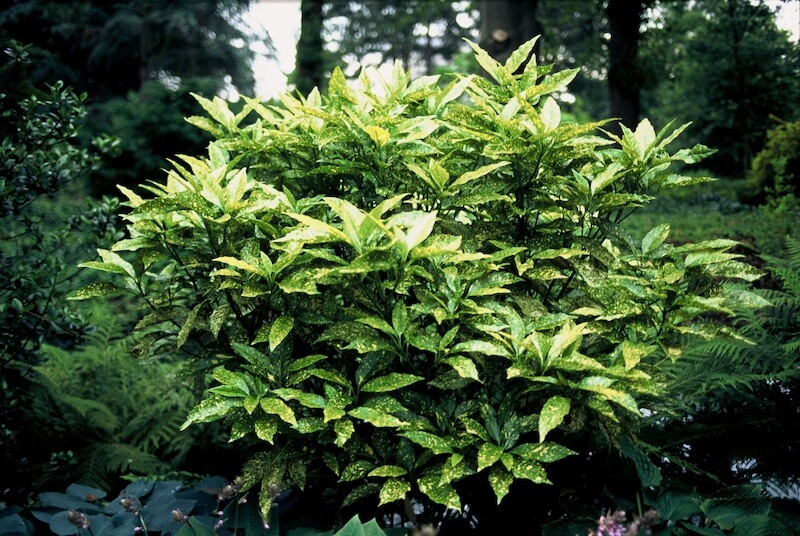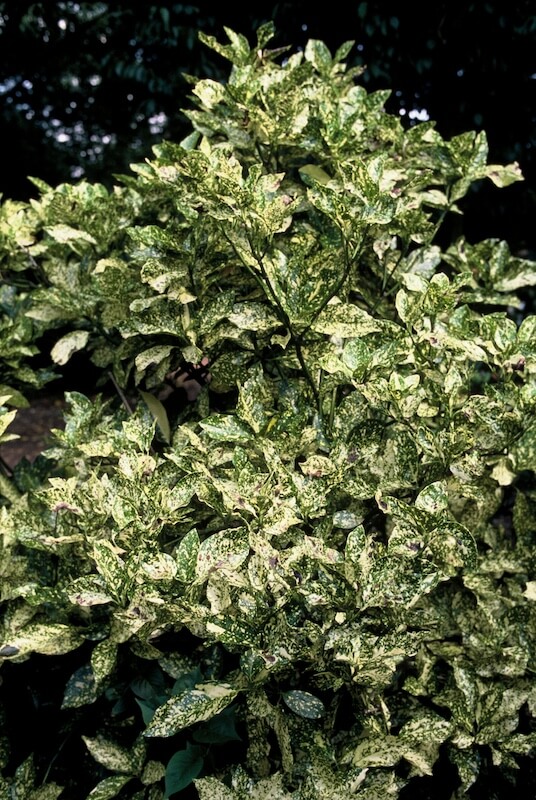
Position
- Thrives in partial to deep shade, making it ideal for north or east-facing sites
- Tolerates full shade under trees or alongside walls and fences
- Protect from cold, drying winds, which can scorch leaves, especially in exposed or coastal locations
Hardiness
- Hardy to approximately –15°C (5°F)
- Well-suited to most UK gardens, coping with typical winters
Soil
- Prefers fertile, moist but well-drained soil
- Highly tolerant of most soil types, including clay and sandy soils, if improved with compost or well-rotted manure
- Very tolerant of urban pollution and salt-laden coastal air
- Grows in acid, neutral, or alkaline soils
- Extremely adaptable to a range of garden soils as long as drainage is provided
- Grab a soil test kit and ensure the perfect conditions for growth
Height
- Usually reaches 1.5–2.5 metres (5–8 feet) after 5–10 years
- Forms a dense, bushy, evergreen shrub with a rounded habit
Seasons of Interest
Additional Notes
- Prune in spring to maintain shape and remove any frost damage; very tolerant of hard pruning
- Water well during dry spells, especially when newly planted or if grown in containers
- Mulch with organic matter in spring to conserve moisture and improve soil health
- Pest and disease resistant; very low maintenance
- Can be grown in containers and is reliable for difficult, dark garden corners
- Drought tolerant once established, but looks best with occasional watering in dry periods
Aucuba japonica Crotonifolia - The Shade-Loving Wonder
Aucuba japonica Crotonifolia, often called spotted laurel or Japanese laurel, is one of the most useful and attractive evergreen shrubs in UK gardens. With its striking variegated foliage, tolerance of dry shade, and ability to thrive in difficult conditions, it’s a smart and stylish choice for gardeners who want colour and structure all year round.
Whether you’re planting a hedge, brightening shady borders, or looking for a bold specimen shrub, this resilient evergreen delivers. Its leathery leaves, bright red berries when pollinated, and compact habit make it as beautiful as it is tough.
What is Aucuba japonica Crotonifolia?
Aucuba japonica Crotonifolia is a bold, evergreen shrub with large yellow-splashed leaves. It’s a female cultivar of the Japanese spotted laurel, a plant native to East Asia.
The green leaves are thick, leathery, and speckled with golden-yellow blotches—earning it the common name “spotted laurel.” It grows slowly into a rounded shape, reaching up to 2.5 metres in height and spread. It’s part of the Garryaceae family and has become a staple in British gardens for decades thanks to its resilient nature and bold foliage.
Aucuba japonica crotonifolia is especially useful in shady areas of the garden, where other plants often fail. When paired with a male aucuba variety, the female crotonifolia can produce attractive red berries when pollinated, adding interest from autumn into winter.
Why choose Aucuba japonica Crotonifolia for your garden?
If you’re dealing with awkward, inhospitable spots like dry shade or pollution and salt-laden conditions, this is the shrub for you. Aucuba japonica Crotonifolia can thrive in inhospitable locations, making it ideal for city gardens, coastal plots, and shaded courtyards.
Its bold, variegated leaves offer year-round interest and pair well with other shade-tolerant shrubs, such as mahonia, fatsia, and sarcococca. Few plants offer such reliable performance with so little maintenance.
This evergreen shrub with large foliage is also a brilliant candidate for underplanting beneath trees, edging pathways, or forming a low-maintenance hedge. It’s hardy throughout the UK and has been awarded the Royal Horticultural Society’s Award of Garden Merit for its outstanding garden performance.

What conditions does Japanese laurel need to thrive?
Aucuba japonica Crotonifolia prefers moist but well-drained soil, though it copes with a wide range of types, including dry soils and coastal conditions. Avoid waterlogged areas, but otherwise it’s forgiving.
While it tolerates sun or shade, its best leaf colour appears in part shade. In a sunny position, the foliage may scorch in very hot spells, especially on dry ground. Add mulch in spring to lock in moisture and improve soil quality.
It thrives in full shade, making it a top choice for the north side of fences, under mature trees, or behind buildings. Its ability to shrug off salt-laden air makes it perfect for coastal gardens.
How big does Aucuba japonica Crotonifolia get?
With a mature height and spread of 1.5 to 2.5 metres, Aucuba japonica Crotonifolia forms a neat, rounded shrub that retains its shape well.
Growth is steady but not rapid, which means you won’t spend your weekends constantly clipping. It’s compact enough for smaller gardens yet robust enough to act as a structural plant in larger borders. You can allow it to grow naturally or lightly prune to maintain its size.
Whether used as a standalone specimen shrub or grouped for impact, its bold leaves and tidy form make it a reliable feature year after year.
Can Aucuba japonica Crotonifolia be used as a hedge?
Yes—and it makes an excellent dense hedge. It forms a thick wall of evergreen foliage, providing year-round privacy and structure.
Plant at 60cm intervals to form a solid hedge. You can leave it to grow naturally or clip it once a year for a tidy outline. Its resilient character and shade tolerance mean it excels in tough hedging spots, such as alongside buildings, under trees, or next to roads.
Its variegation adds interest to what could otherwise be a plain green screen, and if you plant both male and female forms, you’ll get the bonus of red berries in autumn and winter.
How do you prune Aucuba japonica Crotonifolia?
Aucuba japonica Crotonifolia needs very little pruning, but a light tidy in spring will keep it looking sharp.
To prune, remove damaged or straggly stems after the worst of winter has passed. You can also cut back up to one-third of the plant to rejuvenate older shrubs. This encourages strong new growth and maintains a good shape.
For hedges, trim in late spring or early summer. Avoid cutting back in autumn, as winter frosts may damage new growth. If you’re growing for berries, prune lightly to preserve flowering stems.
Does Aucuba japonica Crotonifolia produce flowers and berries?
Yes, although it’s grown primarily for its foliage, Aucuba japonica Crotonifolia also flowers in April and May.
The small, maroon-purple blooms may not be showy, but they’re followed by bright red berries when pollinated by a nearby male. These berries persist into winter, adding a splash of colour and interest.
To enjoy berries, grow a male aucuba nearby—such as Aucuba japonica Rozannie—to ensure cross-pollination. It’s a good idea to plant them in pairs or small groups for best results.
Can it be grown in containers or pots?
Absolutely. This evergreen shrub is well-suited for large pots or containers, particularly in shaded patios or on balconies.
Use a loam-based compost with added grit for drainage. Water regularly in summer and feed with a slow-release fertiliser in spring. It’s a good idea to top-dress annually with fresh compost and mulch to retain moisture.
Container-grown aucuba can be moved to fill seasonal gaps or to act as a focal point near doorways or paths. Its glossy leaves and neat habit add instant structure and colour.
Is Aucuba japonica Crotonifolia suitable for formal and informal garden designs?
This horticultural gem works beautifully in both formal layouts and informal plantings.
Its bold shape, striking foliage, and neat habit allow it to complement architectural designs, gravel gardens, or shade-loving borders. Whether planted in a clipped hedge or allowed to grow freely as a resilient evergreen shrub, it adds interest and structure.
It blends well with other shade-tolerant shrubs and perennials, offering year-round appeal. Its ability to thrive in neglected corners makes it a real problem-solver for UK gardens.
From Darren’s Patch
Growing up, this was one of those plants that quietly did its job year after year in our family garden — tucked beneath a Monkey Puzzle tree, never fussy, always looking good. Even though I don’t have one in my current patch, I still recommend it all the time, especially for those tricky, shady corners where other plants give up. Its bold, spotted foliage lifts a gloomy space, and if you pop a male nearby, the berries are a lovely bonus come winter. For beginners or seasoned gardeners alike, this is one of those dependable shrubs that just gets on with things — no drama, no hassle. If you’re after year-round structure without the high maintenance, Crotonifolia is a solid choice.
![]()
Key Points to Remember
- Aucuba japonica Crotonifolia is a resilient evergreen shrub ideal for shady areas of the garden
- Its variegated leaves and bright red berries, when pollinated, provide year-round colour and structure
- Tolerates dry shade, coastal exposure, pollution and salt-laden air—perfect for inhospitable conditions
- Forms an excellent dense hedge or works as a standalone specimen shrub
- Grows up to 2.5m in height and spread, with a neat, rounded shape
- Minimal maintenance—just a light prune in spring to shape or rejuvenate
- Thrives in a wide range of soils, especially when improved with compost and mulch
- Can be grown in pots, borders, or hedging schemes
- Widely available at nurseries and garden centres—easy to buy Aucuba japonica throughout the year
- Endorsed by the Royal Horticultural Society with the Award of Garden Merit
For year-round interest and dependable performance, you’ll find few shrubs as tough or attractive as Aucuba japonica Crotonifolia. Whether you’re starting a new shade border or reviving a tired corner, this plant delivers results with very little fuss.
Want to learn about other shrub varieties? Read about Aronia x prunifolia Aron here.
For more information on Shrubs for your garden, please click here.

Frequently Asked Questions
Q: What is Aucuba japonica Crotonifolia commonly known as?
A: Aucuba japonica Crotonifolia is commonly referred to as spotted laurel, Japanese laurel, or Japanese spotted laurel. It is a hardy, evergreen shrub prized for its striking, variegated foliage. The glossy green leaves are splashed with golden-yellow markings, making it a valuable addition to shaded or low-light areas in the garden. Its resilience and year-round colour have made it a popular choice for informal hedging, urban planting, and low-maintenance borders.
Q: Where is the best place to plant Crotonifolia in the garden?
A: Aucuba japonica Crotonifolia thrives in full shade to partial shade, making it ideal for shady areas of the garden where other shrubs may struggle. It tolerates a wide range of soil conditions, including dry soils, and is particularly well-suited to coastal locations due to its resistance to salt-laden air. Whether used as a specimen shrub, dense hedge, or part of a mixed border, it offers reliable structure and colour year-round.
Q: How large does Aucuba japonica Crotonifolia grow?
A: This evergreen shrub typically reaches a height and spread of around 1.5 to 2.5 metres (5 to 8 feet), making it a substantial choice for hedging or background planting. It’s a shrubby plant with large, leathery leaves that provides year-round structure and seasonal interest, particularly when its bright red berries appear following pollination. Pruning can help shape its growth and keep it compact in smaller spaces.
Q: How do I care for Japanese laurel, and when should I prune it?
A: Japanese laurel is notably resilient and requires minimal maintenance. It benefits from a light prune in spring, particularly after flowering, to maintain shape and encourage bushier growth. Apply a layer of mulch annually and feed with a balanced, slow-release compost in spring. Water during dry spells in its first year, but once established, it’s highly drought-tolerant and can thrive in inhospitable sites.
Q: Does Aucuba japonica Crotonifolia produce flowers and berries?
A: Yes, this evergreen shrub produces small purple flowers in April and May, followed by bright red berries when pollinated, typically by a nearby male aucuba. While the flowers are modest, the berries are striking and provide seasonal interest in autumn and winter. These berries are not only ornamental but also highly valued for their support of wildlife.
Q: Is Spotted Laurel suitable for hedging?
A: Absolutely. Crotonifolia forms an excellent, dense hedge with year-round interest. Its thick foliage, tolerance of pollution, and adaptability to dry shade and urban conditions make it particularly well-suited for creating privacy screens, informal hedges, or windbreaks. It’s a top choice for gardeners seeking a low-maintenance structure in either a sunny or shady location.
Q: Is Aucuba japonica Crotonifolia hardy in the UK?
A: Yes, this shrub is fully hardy throughout the UK and withstands both cold winters and coastal conditions. It’s tough, leathery leaves resist wind and salt damage, making it ideal for coastal gardens, urban environments, and low-maintenance planting schemes. Its adaptability and longevity have earned it the RHS Award of Garden Merit.
Q: Where can I buy Aucuba japonica Crotonifolia?
A: Aucuba japonica Crotonifolia is widely available at reputable garden centres and online nurseries across the UK. When searching for Aucuba japonica, look for healthy, bushy specimens with well-defined variegation. Many suppliers also offer male varieties, essential for berry production if that is a desired feature.
